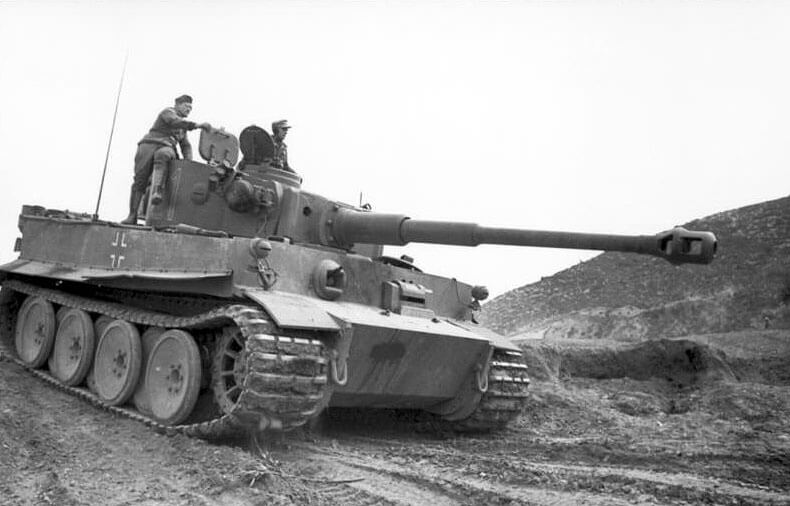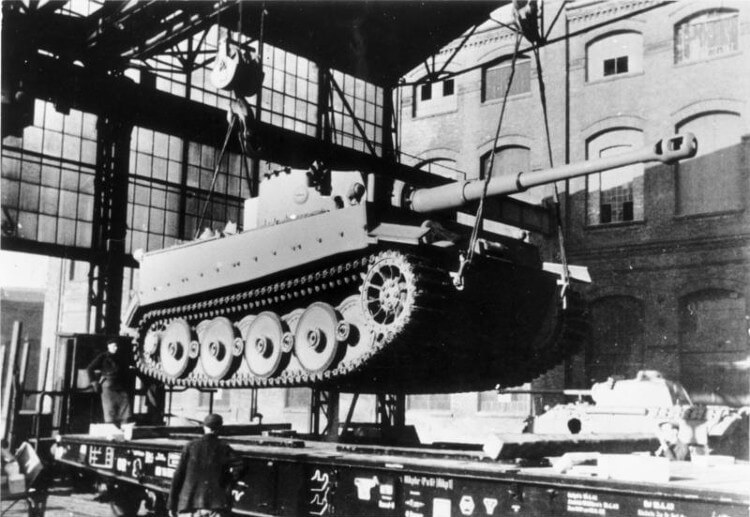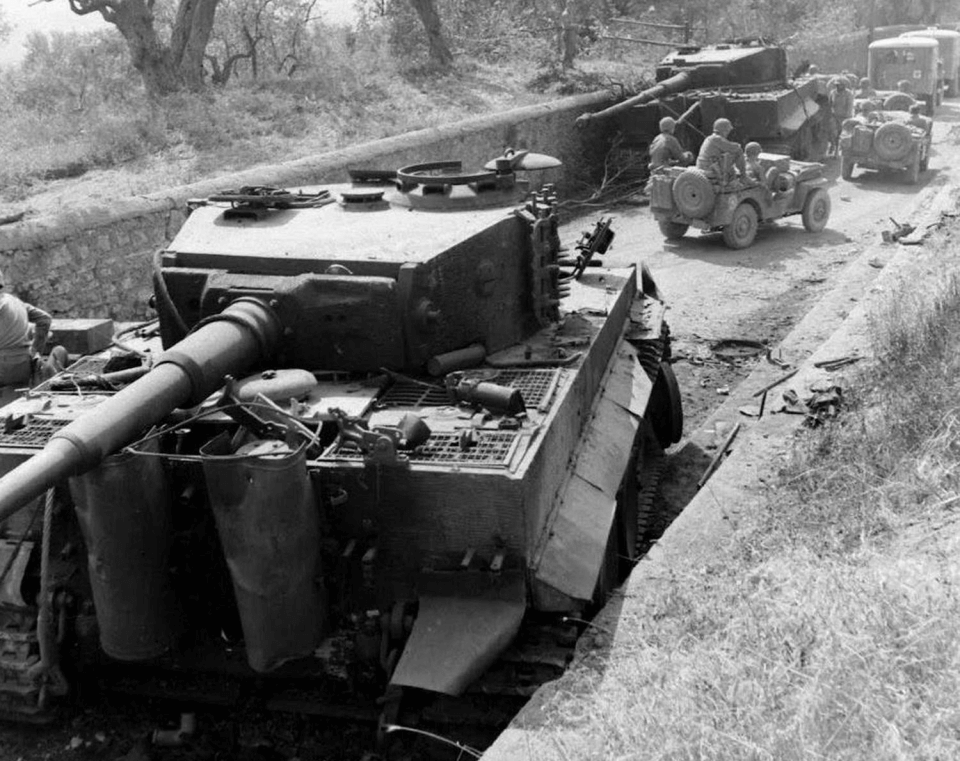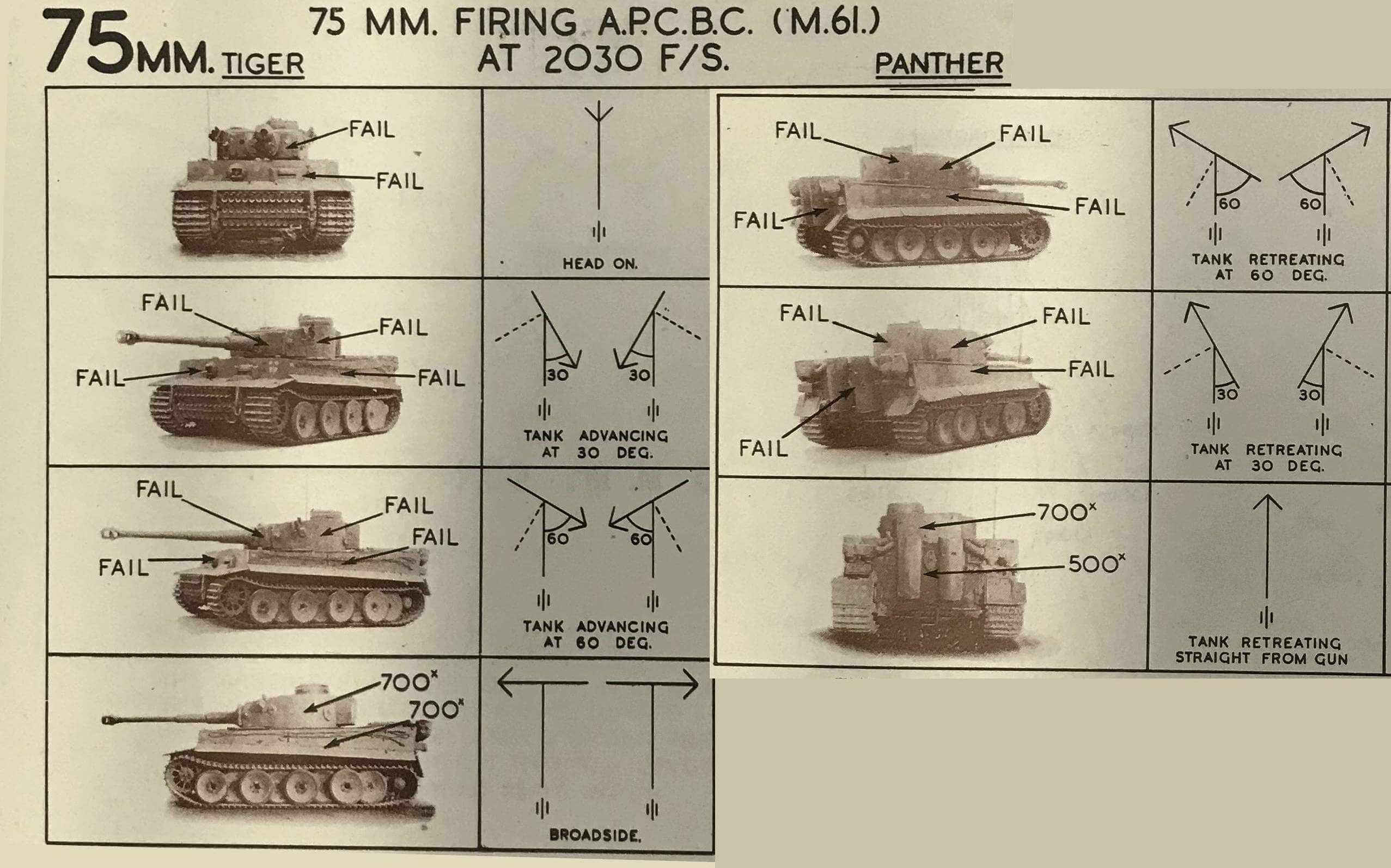Commanders!
The
 VII
VII
Tiger I
was one of the fiercest and most feared tanks of the Second World War. Its deadly 88 mm gun, seemingly impenetrable 120 mm armor, coupled with the ghostly tales it carries, traveled from soldier to soldier and proved for a gut-wrenching combination. It struck as an imposing figure on the battlefield, and at first, Allied tanks were outgunned and outranked in comparison.
But was the Tiger a true goliath or just a figment of Nazi propaganda? We thought we'd turn back the history pages and examine how Allied crews were able to disable this intimidating German hunter. Dive in!
Tiger I: A Formidable Foe
 A German Tiger I tank crew preparing for battle.
A German Tiger I tank crew preparing for battle.  A German Tiger I tank crew heading into battle.
A German Tiger I tank crew heading into battle. Left image: A German Tiger I tank crew preparing for battle. Right image: A Tiger I on the move.
September 1942. The first Tigers roll out to face the Red Army on the Eastern Front near Leningrad. Less than three months later, they square up against the Allies in the Tunisian desert. During that time, the Tiger quickly established a fearsome reputation. Its thick armor startled crews that despairingly saw their shells bounce off the Tiger's hull and turret. In one early encounter in Tunisia, eight rounds fired from a 75 mm artillery gun bounced off of the side of the tank from a distance of just 45 meters.
By contrast, most Allied tanks were vulnerable to the Tiger at 2,000 meters, but most had to come within a few hundred meters to stand any chance of disabling the Tiger. Even with the rapid upgrade of the 75 mm gun to the high-velocity 76 mm gun, the original Sherman was only capable of defeating the Tiger at close range or from the flank. In the first couple of years of action, mechanical failures proved deadlier to Tigers than combat action.
 A German Tiger I tank crew preparing for battle.
A German Tiger I tank crew preparing for battle.  A Tiger I on the move.
A Tiger I on the move. Left image: A German Tiger I tank crew preparing for battle. Right image: A Tiger I on the move.
1,347 Tiger I tanks left the factory doors from August 1942 until the end of the war. While production greatly lagged behind compared to the 40,000 American M4 Shermans and 50,000 Soviet T-34s in circulation, the Tiger I claimed a phenomenal 9,850 kills for the loss of just 1,715 machines (including tanks recovered and returned to service). Sherman crews suffered a 580 percent loss rate in contrast.
“The most important strengths of the Tiger I were the 88 mm gun, the optics, and the armor. It could face T-34s and destroy enemy tanks from distances we never could dream about before. We never shot at 2,000 or 3,000 meters. It was a waste of ammunition! I always fired at all enemy tanks at a range of 700–800 meters to guarantee all tanks hit were destroyed with a single shot… and because at 700–800 meters, you weren't able to fail!"
– Otto Carius, German Tank Commander
Fear Factor: Justified or Heightened Propaganda?
Goebbels' relentless propaganda machine played an important role in glorifying the Tiger. Notorious tank aces, such as Michael Wittmann, were thrust into the spotlight and generously decorated for their battlefield successes. In a complete juxtaposition, Allied and American soldiers were portrayed as paralyzed combatants who had no answer to the Tiger I's armor and firepower.
 A Tiger I loaded onto a special rail car at the Henschel plant, 1942. Credit: Bundesarchiv, Bild 146-1972-064-61 / CC)
A Tiger I loaded onto a special rail car at the Henschel plant, 1942. Credit: Bundesarchiv, Bild 146-1972-064-61 / CC)  A Tiger I in Italy.
A Tiger I in Italy. Left image: A Tiger I loaded onto a special rail car at the Henschel plant, 1942. Right image: A Tiger I in Italy.
Naturally, this is not exactly true, and you should not believe everything you're told. Many Tigers encountered limiting technical issues. The Allies captured several of them and conducted extensive performance and penetration tests throughout the war. They identified the weak spots of the Tiger I—information disseminated to designers, engineers, and tank crews, who began to develop new tank variations and tactics.
"We have nothing to fear from Tiger and Panther tanks. We have had no difficulty in dealing with German armor.”
– Bernard Montgomery, British Field Marshal, in response to the “Tiger Terror” in Normandy.
Allied Response: Fighting the Tiger Threat
 Burnt-out Tigers near Cori, Italy.
Burnt-out Tigers near Cori, Italy.  An American soldier inspecting a Tiger I shell penetration.
An American soldier inspecting a Tiger I shell penetration. Left image: Burnt-out Tigers near Cori, Italy. Right image: An American soldier inspecting a Tiger I shell penetration.
Fresh tactics required nerves of steel, while others called for a steady hand and pinpoint accuracy. Of course, there were numerous considerations to take into account—terrain, weather conditions, nature of the defense or attack, and so on—but here are some of the Allies' key principles and responses to overcome the Tiger menace:
Out-Gun and Out-Perform
Soon, the Tiger had to face the powerful IS-2 and the ISU-152—armed with powerful 122 mm and 152 mm armaments, respectively. They were highly effective at destroying enemy Tigers. The Soviets also developed the 85 mm anti-tank gun, which was mounted on the ferociously mass-produced T-34s to form the T-34-85. Later came the SU-85, which could effectively knock out Tigers from a greater distance.
The 17-pounder gun, mounted on the Sherman Firefly and some M10 tank destroyers, was the British answer to the Tiger problem and could effectively penetrate their armor. Over 2,000 were produced, while the 90 mm guns of the American M36 tank destroyer—later of the M26 Pershing—also demonstrated a capable counterthreat.
Interactive image. Slide between the two images to compare the penetration values of the 75 mm gun and the 17-pounder, the latter considerably more successful at penetrating the Tiger tank.


Get Up Close and Personal
Either flank and engage from the side and rear, or let the Tiger come close to you. Hold your nerve and wait until they are within range. That was the advice given to tank crews. Luring the Tiger from cover, getting it to expose its side and rear armor, then knocking it out from a range of around 450 m seemed to be the way to go. They just had to make their first shot count!
Target Tiny Weakspots
The Tiger was littered with small weak spots. For example, the commander's cupola was exposed as a high and flimsy hatch and merely welded onto the turret. As a result, it was easy to aim at and immobilize the commander. Crews were encouraged to aim at the gun, machine gun port, tracks, commander's cupola, and fuel tanks. This example of a Soviet directive was based on early encounters with Tigers on the Eastern Front and was quickly shared with Allied counterparts to help neutralize the threat.
 A German tank crew inspecting a non-penetrating hit on a Tiger I. Credit: Bundesarchiv, Bild 101I-022-2935-24 / CC.
A German tank crew inspecting a non-penetrating hit on a Tiger I. Credit: Bundesarchiv, Bild 101I-022-2935-24 / CC.  Shell penetrations inside a Tiger I.
Shell penetrations inside a Tiger I. Left image: A German tank crew inspecting a non-penetrating hit on a Tiger I. Right image: Shell penetrations inside a Tiger I.
Hunt in Packs
Ambushing Tigers through coordinated efforts proved highly successful. Blinding their crew and targeting them from multiple angles meant they struggled to identify the main threat, select multiple targets, aim, and return fire effectively.
American tank units also relied on close air, artillery, and tank destroyer support. Five-tank platoons were instructed to split into two groups: one to draw the German fire, the other to maneuver to the flank and engage the tanks from the side or rear.
"Even mass firing of all weapons can reduce the fighting power of the 'Tiger,' because even if the strong armor isn't penetrated, damage to sensitive parts occurs—tracks and suspension, weapons, turret ring, optics."
– German Upper Command, Training Division Note
 King George VI inspecting the captured German Tiger I—later Tiger 131— with the British army in Tunis, June 1943.
King George VI inspecting the captured German Tiger I—later Tiger 131— with the British army in Tunis, June 1943.  The captured German Tiger I tank—later Tiger 131—on May 6, 1943.
The captured German Tiger I tank—later Tiger 131—on May 6, 1943. Left image: King George VI inspecting the captured German Tiger I with the British army in Tunis, June 1943.
Right image: The captured tank on May 6, 1943.
Every true tank enthusiast has heard of the iconic
 VI
VI
Tiger 131
—a legend captured during the German advance in North Africa that ultimately made its way to The Tank Museum in Bovington. It's the only operational Tiger in existence today, after being disabled by British forces nearly 80 years ago, in April 1943.
In 1943, the British 2nd Battalion Sherwood Foresters were ordered to engage several Tiger tanks from the German 504th Heavy Panzer Battalion at Gueriat el Atach, known as Point 174, in Tunisia. After forming a pincer movement, one of the Churchills managed to secure a lucky hit on the Tiger's turret ring and wedge the gun as it was traversing. The supposedly injured or immobilized German crew then abandoned the tank in good working order. This proved invaluable to the Allies, who shipped it back to England to run tests and pinpoint vulnerabilities.
